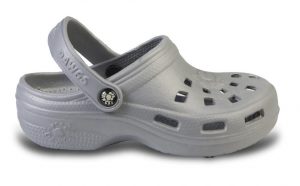Crocs and the Importance of their Intellectual Property
We all recognize the brand! Crocs has sold over 850 million pairs of their iconic shoes in over 85 different countries since 2002. Today, Crocs offers numerous models of shoes. However, the company’s success can be attributed to their original clog-style shoe named the “Classic Clog.” The Classic Clog is made from a resin-based material known as Croslite. This material allows the shoe to be durable while offering the user exceptional comfort. These features have led Crocs to market its clog design for use across a variety of applications including boating, gardening, hiking, and even hospital-use.
The company adopts strict intellectual property policies to prevent competitors from copying the design of their famous clog. These strict policies help to sustain the sales and success of the company. Crocs even warns potential copiers on its website, stating: “DO NOT COPY our products. We aggressively prosecute counterfeiting, intellectual property infringement, and customs seizure actions worldwide.” Thus, it appears that Crocs takes their intellectual property very seriously. However, exactly what intellectual property rights does the company seek to protect?
What Intellectual Property does Crocs Have?

Crocs has ample legal protections for its shoe designs through various intellectual property rights. These intellectual property rights give the company several avenues for litigating potential infringement on their products. In fact, Crocs has been granted utility patents, design patents, trademarks, trade dress, and even copyright protection for their products — and not just in the US!
The importance of multiple IP rights is given light by recent litigation concerning trade dress and design patent rights in connection with the Crocs Classic Clog.
The Trade Dress Suits
In July 2021, Crocs filed a trademark infringement lawsuit against 21 companies, including large retailers like Hobby Lobby and Walmart. A trademark is any word, phrase, symbol, design, or a combination of these things that identifies the source of a good or service. Infringement occurs when someone else uses a mark that is the same or similar enough to cause a likelihood of confusion between the infringer’s goods and services and your goods and services. To win a trademark infringement suit, a plaintiff must show that they have a valid trademark and that the defendant(s) are using the same or similar trademark such that consumers would be confused about the source of a particular good or service. Trademarks include not only words like the Crocs name but can also include the design of product if that design indicates the source as a trademark must. These types of trademarks are called a trade dress.
Two of the trademarks in the case, U.S. Trademark Registration No. 5,149,328 and U.S. Trademark Registration No. 5,273,875, protect the Classic Clog’s product design, which is a type of trade dress. Crocs’ lawsuit alleged that defendants were copying the trademarked design of the Crocs clog. In September 2022, Crocs settled the trademark suit against Walmart, but litigation with the other defendants remains active. Further, Crocs has also been litigating other types of intellectual property lately – their design patents.
The Design Patent Suits
In addition to the trademark suits, Crocs has been battling over the validity of one of its design patents in recent years. A design patent covers the ornamental look, rather than function of utility patents that most people are more familiar with. In other words, design patents protect the ornamental look and features of an invention, rather than how it works.
Crocs’ filed the design patent, U.S. Patent No. D517,789 (“the ‘789 patent”), for the Classic Clog on May 28, 2004. The ‘789 patent faced multiple validity challenges during its lifetime.
Double Diamond, a subsidiary of the footwear company Dawgs, challenged the validity of the ‘789 patent after Crocs filed suit against them for infringing the ‘789 patent. Dawgs responded by filing an inter partes review, which is a petition to have the validity of the ‘789 patent reviewed by the Patent Trial and Appeal Board (PTAB). The PTAB found Crocs had invalidated their own patent by anticipation. A patent is anticipated when the invention is publicly disclosed in one single source prior to the filing of the patent application. In other words, if an invention is anticipated it is not new. In Crocs’ case, the ‘789 patent was anticipated because Crocs had listed the clogs for sale on their website for more than a year (prior to May 28, 2003) before the patent application was filed.

Can Crocs Still Protect the Clogs from Being Copied Without a Valid Patent?
The short answer in Crocs’ case is yes! Crocs’ had a design patent and trade dress protection for their clog design. When it had both, Crocs had a choice between trademark infringement and design patent infringement action for lawsuits against competitors. Now, Crocs can only bring trademark infringement cases for their Classic Clog. Is Crocs in a worse position by losing out on the ability to bring an action for infringement of the ‘789 patent? The answer is somewhat tricky.
Trade Dress vs Design Patent Protection
Trademark protection is much more limited than design patent protection. Trade dress protection only applies to instances when there is a confusing use of the same design on goods/services in commerce. In other words, trade dress protection applies when a consumer might be confused as to the source of those goods/services. Even if they did bring an action, Crocs would have to prove that there would be a likelihood of confusion between the competitor’s product and the Crocs product. This is proven if consumers would believe that the non-Crocs product is a Crocs product based on the mark. Alternatively, Crocs would not have to worry about proving that there would be a likelihood of confusion under a design patent infringement action. Instead, the analysis would focus more on comparing the design of the accused product to the design of the patented product.
Although design patent protection provides a broader scope of protection than trademark protection, the protection is still limited. Design patents only last for 15 years. In contrast, trade dress protection could last forever as long as it continues to satisfy trade dress requirements, such as the design continuing to identify its source and being used in commerce. However, design patents, like the ‘789 patent, can be invalidated. A company sued for infringing a design patent can challenge the validity of the patent. If successful, not only is the company not liable, but no other companies can be liable. A patent that is invalid cannot be enforced. This is what happened with Crocs’ ‘789 patent.
While both trade dress and design patent litigation are quite complex, Crocs gives us a little insight into the challenges that come with each form of intellectual property.

Manuel (Manny) Franco
Associate Blogger
Loyola University Chicago School of Law, J.D. 2024
